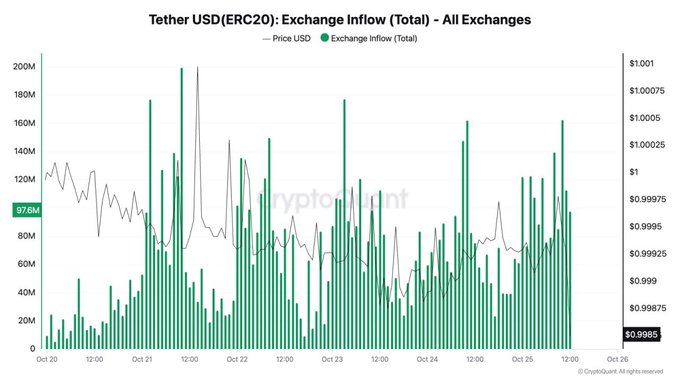The cryptocurrency market is currently facing turmoil following reports of a US investigation into Tether, one of the most important stablecoins on the market.
As uncertainty surrounding the case continues, the ripples from this investigation could spread throughout the cryptosphere. The possible impacts could redefine market direction, guide investor activity and change capital flows, while the industry continues to expect further developments.
WSJ report and Tether's response
According to WSJ, US regulators are currently investigating Tether (USDT). This report has caused concern among market participants and raised a number of possibilities that may arise.
However, Tether's CEO refuted such claims and said that no such investigation is underway at this time. This caused further confusion and provided little reassurance to investors who were still trying to get more information in the dark.

On-chain data shows that USDT injections into exchanges are still hovering around average levels, indicating that traders are not starting to move away from stablecoins en masse. However, USDT price has fallen slightly, suggesting that some traders may be jockeying for positions due to the current news.
The role of Tether in the cryptocurrency market
Tether (USDT) is a major player in the digital asset space, often acting as a bridge between traditional and crypto markets. Its value is pegged to fiat currency, providing stability amidst the well-known volatility of cryptocurrencies. Many investors and traders use USDT to enter and exit more volatile assets such as Bitcoin and other altcoins, making it the preferred tool for maintaining liquidity.
However, questions about the stability of a stablecoin issuer can have a significant impact on the market. Recent news about the US investigation into Tether's operations also casts a shadow on the company's reserve disclosures and overall compliance situation.
If this investigation reveals any ugly developments, it could impact the use of USDT across global exchanges, impacting not only the flow of funds within the crypto market but also the liquidity of the market. will give.
Potential changes in investor behavior
Investors have already expressed concerns about the recent investigation into Tether. This led to a short-term drop in the value of cryptocurrencies as traders braced for the worst. In the past, issues related to Tether have led to more volatility, but also led to sharp market recoveries.

For example, previous cases of instability regarding stablecoin issuers were related to sharp increases in BTC prices. After USDT-related issues in January 2019, Bitcoin increased by 268%, and a similar situation in December 2020 caused Bitcoin to increase by 255%. More recently, in June 2023, Tether-related uncertainty occurred again before Bitcoin's value increased by 200%.
Some market analysts have noted this historical trend and suggested that doubts about Tether could herald another bullish turn in the market. Once investors regain confidence, they may move their funds from the relatively stable USDT to riskier assets such as Bitcoin and altcoins, thereby increasing the prices of these assets.
USDT advantage and impact on market liquidity
Investigation of stablecoin issuers may also impact USDT market share, which refers to the share of market capitalization of stablecoin issuers relative to other cryptocurrencies. Additionally, USDT's dominance has been declining since March 2024, and news of the survey added further pressure to this trend.
USDT’s declining market share means investors are more likely to venture into riskier assets than USDT, namely BTC and other cryptocurrencies.
As investors exit USDT, liquidity can be spread across other cryptocurrencies, potentially diversifying market conditions. This change could increase trading volumes for other digital assets and could just be a precursor to a broader market rally. However, if the use of USDT is restricted or limited as a result of the investigation, it may cause problems for some exchanges and traders as they may not be able to easily meet their trading needs.
Broader economic and regulatory implications
The impact of the U.S. investigation into Tether could extend beyond the crypto market and impact broader financial stability. In some countries, especially those with unstable banking systems, stablecoins like Tether have become an important medium for transactions. USDT turmoil could push users back into volatile currencies, exacerbating financial challenges in these regions.
Additionally, regulatory scrutiny of stablecoin issuers is likely to increase calls for greater transparency across the stablecoin sector. This is likely to result in tighter oversight of other stablecoin issuers, with the aim of ensuring that their reserves are fully backed and verifiable. Tighter regulation may boost institutional investor confidence, but it could also limit the flexibility and innovation that characterize crypto markets.
At the same time, scrutiny of centralized stablecoins like Tether could increase interest in decentralized finance (DeFi) solutions. Decentralized stablecoins are designed to operate without a central issuer and are likely to see increased adoption as investors seek more transparent alternatives.
Disclaimer: The content presented may contain the personal opinion of the author and is subject to market conditions. Do your market research before investing in cryptocurrencies. The author or publication assumes no responsibility for your personal financial loss.


✓ Share: